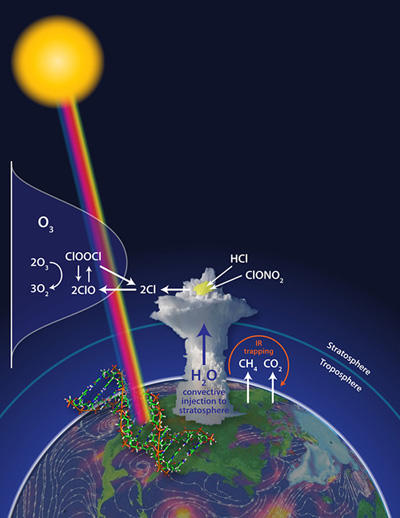Climate Change & Atmospheric Chemistry
While past climates have had high water vapor concentrations in the stratosphere, the Earth system has never simultaneously had high water vapor concentrations and high halogen loading as may well be the case now under high levels of climate forcing by unprecedented levels of CO2.
It is a remarkable fact that perhaps the most important observation coupling climate forcing to UV dosage levels at the surface at mid-latitudes is the observation of high (e.g. > 10 ppmv) water vapor and low temperatures (< 210 K) with the simultaneous determination of BrO and ClO in the lower stratosphere at mid-latitudes. Yet this combination of observations has never been included in a mission strategy. We have a number of observations of high water and low temperatures at mid-latitudes. We have observations of BrO in the presence of low water. But we do not have BrO and ClO observations in the presence of high water vapor and low temperatures, which is the critical combination of conditions to appraise this climate-ozone feedback.
Most Recent Publication:

In the context of climate−chemistry coupling globally, the central United States in summer represents a combination of factors specific to both the geographic region and the season. Northerly flow of warm moist air from the Gulf of Mexico in combination with heating and convergence over the Great Plains frequently triggers powerful convection that injects water vapor into the stratosphere, where the upper level anticyclonic flow associated with the NAM can sequester the injection for up to a week or more over the United States. These conditions, in combination with cold stratospheric temperatures, can lead to heterogeneous catalysis on ubiquitous sulfate−water aerosols that converts inorganic chlorine to ClO and can initiate ozone loss through an array of gas-phase catalytic cycles. Potential future enhancements in sulfate from volcanic injection or geoengineering increase the likelihood of halogen activation and ozone loss.
